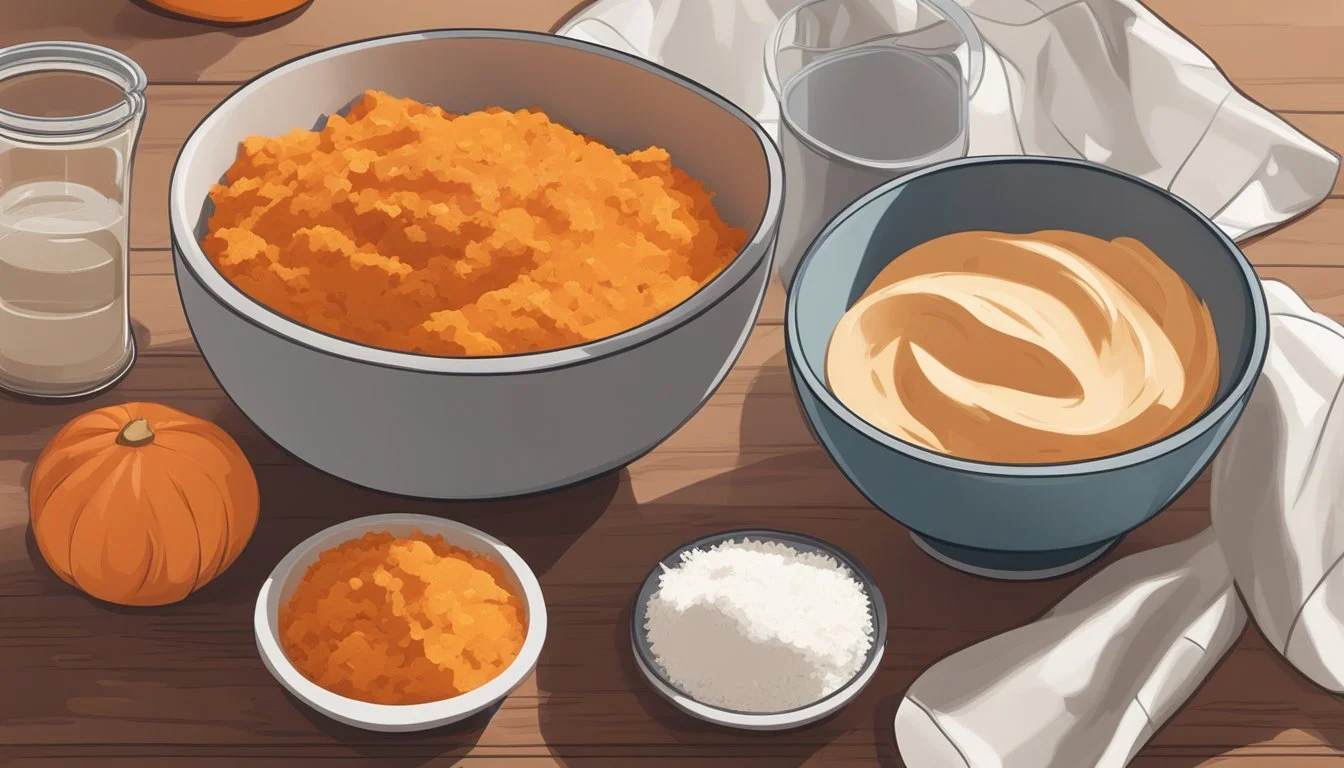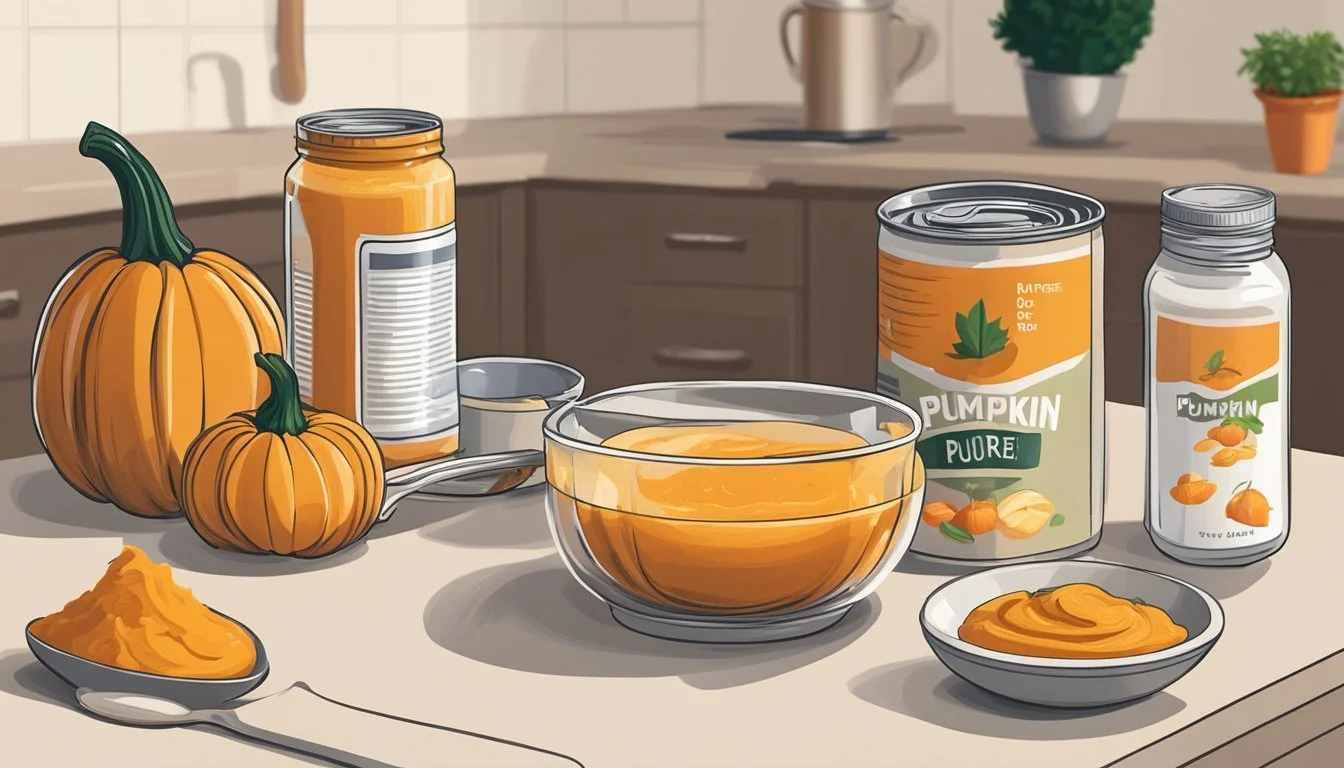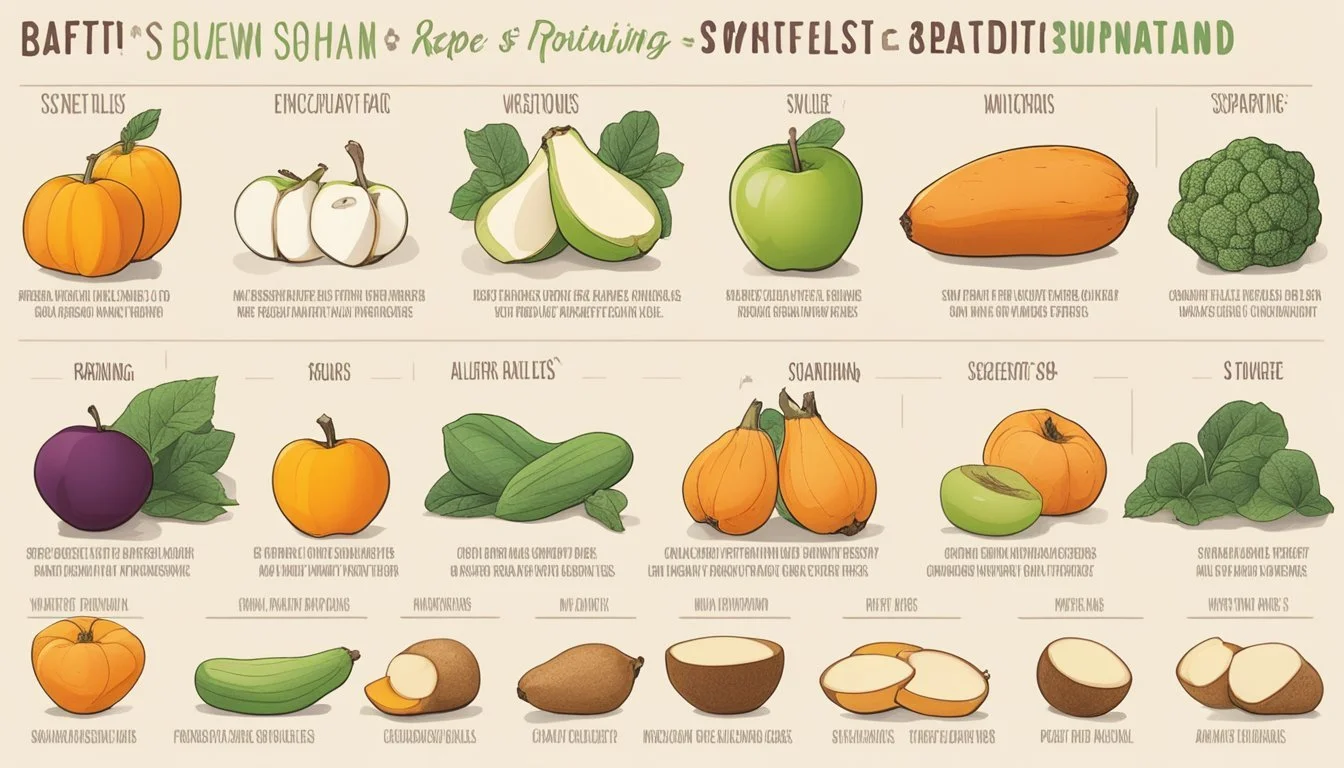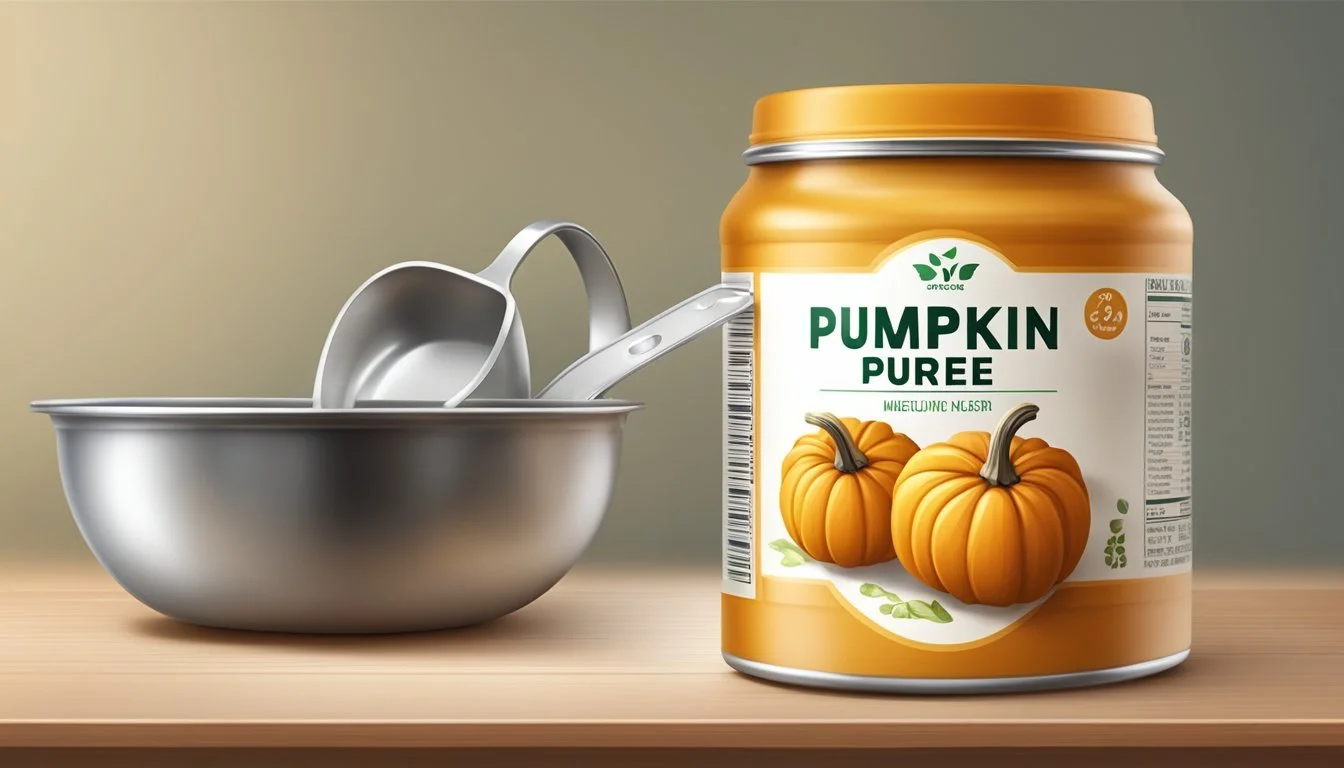Pumpkin Puree Substitutes
Top Alternatives for Your Recipes
Pumpkin puree is a staple in many recipes, especially during the fall season. Its creamy texture and subtly sweet flavor make it perfect for pies, soups, and baked goods. However, there are times when pumpkin puree may not be readily available or when a cook might want to experiment with different flavors and nutritional profiles. This is where substitutes come in handy.
Butternut squash is a popular alternative to pumpkin puree. With its similar texture and sweet taste, it is an ideal choice for most recipes that call for pumpkin puree. It's also abundant in nutrients like vitamin A, potassium, and fiber, bringing additional health benefits to the table. Another excellent substitute, acorn squash, can be pureed to match the consistency of pumpkin, offering a slightly different but equally delicious flavor profile.
In addition to squash varieties, other vegetables like carrots and sweet potatoes (What wine goes well with potatoes?) offer their unique tastes and textures as pumpkin puree substitutes. These alternatives not only capture the essence of pumpkin puree but also allow for culinary creativity, giving dishes a new twist while still delivering on the expectation of warmth and comfort in flavor.
Why Substitute Pumpkin Puree?
Substituting pumpkin puree may arise from the need to meet specific dietary requirements or due to availability. This section explores the varied reasons prompting individuals or recipes to call for an alternative to traditional pumpkin puree.
Dietary Restrictions and Allergies
For some individuals, consuming pumpkin may trigger allergies or dietary restrictions, necessitating a substitute. Alternative purees can cater to various nutritional requirements and avoid potential allergens found in pumpkin.
Flavor and Texture Preferences
Pumpkin has a distinct earthy flavor and creamy texture which may not be preferred in all dishes. Substitutes like butternut squash or sweet potatoes can offer a different flavor profile or texture, adding a unique twist or enhancing the taste of the recipe.
Seasonal Availability
Pumpkin season is typically in the fall, and during off-seasons, fresh pumpkin may not be as readily available. Using alternatives like canned squash puree or sweet potato puree ensures that recipes requiring a pumpkin-like consistency can be made year-round.
Nutritional Considerations
Substitutes can be chosen based on their nutritional value, such as high content of vitamins, dietary fiber, and antioxidants. For instance, butternut squash is rich in vitamin A and vitamin C, while sweet potatoes provide a good source of beta-carotene and healthy fats.
When searching for a pumpkin puree substitute, consider one that aligns with your requirements for flavor, sweetness, texture, and nutritional content without compromising the overall integrity of the dish.
Pumpkin Puree Substitutes in Baking
When baking, incorporating the right substitute for pumpkin puree is crucial to maintain the desired texture and moisture of the final product. Each alternative brings its unique qualities to desserts, from muffins to cakes, while ensuring a similar texture and flavor profile to pumpkin puree.
Sweet Potato Puree
Sweet potato puree is an excellent substitute for pumpkin puree in baking. It offers high fiber content, essential vitamins, and a low glycemic index, ensuring it doesn't dramatically spike blood sugar levels. For every cup of pumpkin puree a recipe calls for, one can replace it with an equal amount of sweet potato puree, which will contribute a similar texture and slightly sweet flavor to desserts, especially in pies and muffins.
Butternut Squash Puree
Another great alternative is butternut squash puree. Its mild sweetness and smooth consistency make it nearly indistinguishable from pumpkin in baked goods. One can typically use butternut squash puree in a 1:1 ratio for pumpkin puree. This substitute works exceptionally well in bread and cake recipes, as it maintains the structural integrity and adds subtle nutty undertones.
Banana Puree
Using mashed ripe bananas as a substitute not only imparts a nutritious boost but also keeps the baked goods soft and moist. While banana puree will introduce its own flavor, it can be a delightful twist in some recipes. A good rule of thumb is to use about 3/4 cup of banana puree for every cup of pumpkin puree, as its moisture content is higher.
Applesauce
For those looking to reduce sugar in their recipes, applesauce serves as a beneficial substitute. It keeps desserts moist without adding the extra sweetness. One can use unsweetened applesauce in a 1:1 ratio with pumpkin puree, perfect for more nuanced baked items where the flavor of apples won’t overpower the other ingredients. Applesauce is often a pantry staple, making it a convenient option for last-minute baking.
Pumpkin Puree Substitutes in Cooking
Pumpkin puree is a versatile ingredient commonly used in a variety of dishes ranging from soups to pies. However, when it's unavailable, several substitutes offer similar consistency and nutritional value, making them suitable for cooking applications such as stews, sauces, and smoothies.
Acorn Squash Puree
Acorn squash, a type of winter squash, presents an excellent alternative with a consistency quite similar to pumpkin puree. To prepare acorn squash puree, one needs to halve the squash, remove the seeds, and roast until tender. Pureeing the roasted flesh results in a sweet and creamy texture ideal for dishes like pumpkin pie or pumpkin soup. It not only mimics the color and texture but also contributes vitamins and minerals to the dish.
Carrot Puree
Carrot puree serves as a flavorful substitute, especially in sauces and stews where its natural sweetness and smooth texture align well with pumpkin puree. Carrots are cooked and blended to create a puree that is rich in vitamins and offers a healthy boost to any recipe. Its vibrant color and mild flavor allow it to seamlessly integrate into recipes without overwhelming other ingredients.
Peanut Butter
While not a direct substitute in terms of texture, peanut butter can replace pumpkin puree to add a nutty flavor and dense consistency to certain recipes, such as smoothies or baked goods. Its high content of protein and healthy fats can enhance the nutrition of the dish. However, one should be mindful of the distinctive taste peanut butter brings, ensuring it complements the flavors of the target recipe.
Understanding Pumpkin Puree
Pumpkin puree is a staple ingredient in a variety of recipes, from classic pumpkin pie to comforting pumpkin bread. It's essential to know what this puree is and how it affects the dishes it's used in.
What Is Pumpkin Puree?
Pumpkin puree is simply the flesh of the pumpkin that has been cooked and mashed or blended until smooth. It is commonly available in canned form, but can also be made at home by roasting or boiling pumpkin pieces and then blending them. Canned pumpkin puree is different from pumpkin pie filling, which is pre-sweetened and spiced.
Ingredients: Pure cooked pumpkin, no added sugar or spices.
Homemade puree: Made from sugar pumpkins for best flavor.
Canned puree: Convenient, consistent in texture and moisture.
How Pumpkin Puree Impacts Recipes
The use of pumpkin puree in recipes contributes not only the distinctive pumpkin flavor but also moisture and a creamy consistency. Its smooth texture is perfect for baked goods like pumpkin bread and provides a necessary binding element within the structure of such dishes.
Moisture: Adds a moist quality to recipes, particularly in baked goods.
Consistency: Creates a smooth and creamy texture in pies and custards.
Flavor: Offers a subtle, earthy pumpkin taste that can be enhanced with spices.
Additional Pumpkin Puree Alternatives
When seeking out substitutes for pumpkin puree, it's important to consider versatility, flavor, and convenience. Below are specific alternatives that offer unique flavors and nutrition, and can be used in a range of recipes from cakes to soups.
Zucchini Puree
Zucchini puree can slip seamlessly into baked goods such as cakes and bread without overpowering their flavors. This vegetable brings moisture and a subtle taste that can enhance sweetness without the need for extra sweeteners. It’s also nutritionally advantageous, providing a good source of vitamins and fiber.
Canned Sweet Potatoes
Canned sweet potatoes are a convenient and flavorful substitute for pumpkin puree, especially in pies and desserts where texture and sweetness matter. Simply drain and mash them for a ready-to-use ingredient that's both time-saving and often more readily available.
Versatility: Suitable for sweet dishes
Nutrition: High in vitamin A and fiber
Flavor: Naturally sweet, reducing the need for additional sugars
Pre-Made Pumpkin Soup
For those in search of a quick meal solution, pre-made pumpkin soup can be transformed beyond soups into a variety of dishes. It’s a convenient option that captures the essence of pumpkin with a complementary blend of spices and seasonings. Use it as a base for sauces or to impart a pumpkin flavor to casseroles.
Convenience: Ideal for fast and flavorful meals
Recipes: Great for soups, sauces, and quick bread
Flavor: Often seasoned, adding a flavorful twist to traditional recipes
Flavor Profiles and Pairings
When selecting substitutes for pumpkin puree, one must consider the flavor profiles and how they pair with various spices, herbs, and foods. The chosen substitute should impart a blend of sweetness and earthy flavors that complement traditional pumpkin dishes.
Suitable Spices and Herbs
The following spices and herbs enhance the flavors of common pumpkin puree substitutes:
Cinnamon: Providers warmth with a woody undertone.
Nutmeg: Offers a nutty and subtly sweet flavor that's ideal for desserts.
Cloves: Adds a bold, spicy kick suitable for robust dishes.
Ginger: Gives a bright, sharp accent that enlivens both sweet and savory recipes.
These spices are often combined in what is popularly known as 'pumpkin spice', responsible for the signature autumnal warmth in many recipes including smoothies and pancakes.
Complementary Foods for Substitutes
Pumpkin puree substitutes blend well with a variety of foods. Here's a reference for suitable pairings:
Sweetness: In baking, substitutes like sweet potatoes maintain the sweetness expected in cakes, pies, and muffins.
Earthy Flavor: For soups or stews, a butternut squash puree preserves the earthy, comforting taste.
Moist Texture: Alternatives such as butternut squash add the required moistness to baked goods, keeping them soft and enjoyable to eat.
Smoothies and Pancakes: Substitutes also should mix well to retain smoothness without overpowering the other ingredients within the dish.
By choosing the right substitute and pairing it with these spices and foods, one can replicate or even enhance the classic pumpkin puree flavor profile and texture in their culinary creations.
Making the Best Use of Substitutes
When opting for pumpkin puree substitutes, it is crucial to understand the substitute's inherent properties and how they can be thoughtfully incorporated into recipes to achieve desired outcomes.
Adjusting to the Substitute's Characteristics
Each alternative to pumpkin puree has its unique characteristics which can affect the consistency, texture, moisture, and nutritional value of the finished dish. Sweet potato puree and butternut squash can offer a creamy and velvety texture similar to pumpkin puree, making them excellent substitutes in both savory and sweet recipes. For a drier texture, one might use mashed bananas, however, bananas will also impart their own flavor and extra sweetness, making them suitable for certain baked goods.
To maintain the moisture balance in a recipe, if a substitute is dryer than pumpkin puree, additional liquids may be necessary.
When a substitute is denser, pureeing or thinning it down with a bit of water or another liquid can help achieve the right consistency.
For baking, a 1:1 ratio is typically a safe starting point, but since each substitute may have differing water content, adjustments should be made accordingly.
Here is a brief comparison of texture and moisture levels in common substitutes:
Substitute Texture Moisture Sweet Potato Creamy, smooth High Acorn Squash Similar to pumpkin Moderate Bananas Soft, dense High
Incorporating Substitutes into Recipes
When using a substitute in a recipe, one should not only consider the cooking method but also the final flavor profile and appearance of the dish. For soups and purees, most substitutes can be seamlessly integrated with little to no modification. However, in baked goods where pumpkin puree is a key ingredient for moisture, sweet potato puree can be a close match due to its similar color, texture, and sweetness.
Roast the substitute to concentrate flavor and reduce excess water.
Blend the roasted flesh until smooth to mimic the texture of canned pumpkin.
Maintain a 1:1 ratio as a starting point, altering it based on trial and testing.
An example of substitute incorporation in a recipe might be using mashed sweet potato in a pie recipe, where the goal is to achieve a creamy texture akin to traditional pumpkin pie. The cook would adjust the sweetness and spices to match the profile of the original dish.
Nutritional Information of Substitutes
When seeking an alternative to pumpkin puree, sweet potato stands out as an excellent option. Sweet potatoes are of particular interest due to their high fiber content and wealth of vitamins such as Vitamin A and C. Additionally, they offer crucial minerals including potassium.
Carrots are another viable substitute, offering a different nutritional profile. They are notably rich in Vitamin A, essential for eye health, and provide a moderate amount of fiber.
Below is a comparative table that provides an at-a-glance view of the nutritional benefits of these substitutes per 100 grams:
Nutrient Sweet Potato Carrot Calories 86 kcal 41 kcal Protein 1.6 g 0.9 g Fat 0.1 g 0.2 g Carbohydrates 20.1 g 9.6 g Fiber 3 g 2.8 g Vitamin A 709 µg 835 µg Vitamin C 2.4 mg 5.9 mg Potassium 337 mg 320 mg
It's clear from the table that both sweet potatoes and carrots contribute significant nutritional value. For those who prioritize a healthier option, sweet potatoes might edge out carrots slightly due to their higher fiber content. However, both are low in fat and make for healthful alternatives to pumpkin puree in various dishes.
Preparation and Storage Tips
When opting for pumpkin puree substitutes, one should consider not only the preparation method but also the ideal storage conditions to maintain freshness and flavor.
Homemade vs. Store-Bought
Homemade pumpkin puree provides a fresh and natural alternative to store-bought varieties, often resulting in a richer flavor profile. For homemade puree, sugar pumpkins are typically recommended due to their sweeter taste and smoother texture. A food processor or blender is essential for creating a smooth consistency.
Preparation:
Wash and halve the pumpkin, removing seeds and stringy fibers.
Roast the pumpkin halves until soft, then scoop out the flesh.
Puree the flesh using a food processor or blender until smooth.
Advantages of Homemade:
No added preservatives or sugars.
Control over the texture and thickness.
Store-bought pumpkin puree is a convenient, time-saving option. Many brands offer organic and 100% pure pumpkin options.
Selection Tips:
Choose cans that list pumpkin as the sole ingredient.
Check for a firm seal and no visible damage to the can.
Optimal Storage Practices
The method of storage impacts both shelf life and quality of pumpkin puree.
Homemade Pumpkin Puree:
Refrigeration: Store in an airtight container for up to one week.
Freezing: Fill freezer-safe bags or containers, leaving some space for expansion. Can be frozen for up to three months.
Canned Pumpkin Puree:
Pantry: Keep unopened cans in a cool, dark place. Typically has a shelf life of one to two years.
Refrigeration: After opening, transfer to an airtight container and refrigerate. Consume within 5-7 days to ensure freshness.
By adhering to these practices, one can ensure the pumpkin puree — whether homemade or store-bought — maintains its quality and flavor, ready for the next culinary creation.
Conclusion
When seeking alternatives for pumpkin puree, one has several viable options. Sweet potatoes serve as an excellent stand-in, boasting high fiber, vitamins C and A, and a lower glycemic index. The consistency and taste closely mimic that of pumpkin puree, making it a versatile choice for baking and cooking.
Acorn squash is another recommended substitute, blended into a smooth and creamy texture. It can be baked and pureed, maintaining the desired density for recipes that call for pumpkin puree. This substitute is particularly effective due to its similar color and texture.
For those favoring a fresh approach, sugar pumpkins can replace canned puree. They should be baked with the cut sides covered in foil until soft. The resulting puree offers a robust flavor profile ideal for pies and savory dishes.
Substitute Texture Similarity Flavor Profile Nutritional Value Sweet Potatoes High Sweet & Creamy High in Fiber, Vit. C & A Acorn Squash Very High Mild & Nutty Rich in Vitamins
Each substitute brings its own unique qualities to the table while fulfilling the role of pumpkin puree. Their versatility is evident, as they can be incorporated into an array of dishes from smoothies to soups, without compromising the integrity of the original recipe. It's advisable to test these substitutes in specific recipes, since the moisture content and flavor profile can vary from that of pumpkin puree.






